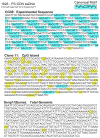Regulation of autoreactive B cell responses to endogenous TLR ligands
- PMID: 20014959
- PMCID: PMC3059585
- DOI: 10.3109/08916930903374618
Regulation of autoreactive B cell responses to endogenous TLR ligands
Abstract
Immune complexes containing DNA and RNA are responsible for disease manifestations found in patients with systemic lupus erythematosus (SLE). B cells contribute to SLE pathology through BCR recognition of endogenous DNA- and RNA- associated autoantigens and delivery of these self-constituents to endosomal TLR9 and TLR7, respectively. B cell activation by these pathways leads to production of class-switched DNA- and RNA-reactive autoantibodies, contributing to an inflammatory amplification loop characteristic of disease. Intriguingly, self-DNA and RNA are typically non-stimulatory for TLR9/7 due to the absence of stimulatory sequences or the presence of molecular modifications. Recent evidence from our laboratory and others suggests that B cell activation by BCR/TLR pathways is tightly regulated by surface-expressed receptors on B cells, and the outcome of activation depends on the balance of stimulatory and inhibitory signals. Either IFNalpha engagement of the type I IFN receptor or loss of IgG ligation of the inhibitory FcgammaRIIB receptor promotes B cell activation by weakly stimulatory DNA and RNA TLR ligands. In this context, autoreactive B cells can respond robustly to common autoantigens. These findings have important implications for the role of B cells in vivo in the pathology of SLE.
Figures



References
-
- Wolfowicz CB, Lyons S, Mahon CA, Marshak-Rothstein A, Rothstein TL. Isolation of self-recognizing IgG2a monoclonal rheumatoid factors. Clin Immunol Immunopathol. 1989;52:313–22. - PubMed
-
- Leadbetter EA, Rifkin IR, Hohlbaum AM, Beaudette BC, Shlomchik MJ, Marshak-Rothstein A. Chromatin-IgG complexes activate B cells by dual engagement of IgM and Toll-like receptors. Nature. 2002;416:603–7. - PubMed
-
- Viglianti GA, Lau CM, Hanley TM, Miko BA, Shlomchik MJ, Marshak-Rothstein A. Activation of autoreactive B cells by CpG dsDNA. Immunity. 2003;19:837–47. - PubMed
Publication types
MeSH terms
Substances
Grants and funding
LinkOut - more resources
Full Text Sources
